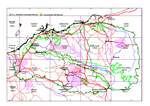Click on images
to enlarge



Photographer: B.R. Maslin

Photographer: B.R. Maslin

Photographer: B.R. Maslin

Photographer: B.R. Maslin
, seeds (close), S Midgley SM606, lab photo by Fiona McCallum ADJUSTED_sml.jpg)
Seed from one herbarium voucher. Scale in mm. Photographer: F. McCallum.
Botanical name
Acacia minyura Randell, J. Adelaide Bot. Gard. 14: 126, figs 1Q-R (1992)
Common name
Desert Mulga
Description
Multi-stemmed, rounded or obconic shrubs 1-4 m tall and about the same across, crown dense, main stems fairly straight. Bark dark grey, longitudinally fissured at base of main stems otherwise smooth. Branchlets with thick and crenulated resin ribs at extremities, minutely sericeous between the ribs but the hairs often obscured by resin. New shoots enveloped by a thick layer of resin when first initiated (the resin red-brown and translucent, but often milky blue-grey and opaque in non-Pilbara plants), aging pale green with a sheen. Phyllodes narrowly oblong or oblong-elliptic, occasionally lanceolate, 9-30 mm long, 2-4 mm wide, straight to very shallowly recurved, rarely very shallowly sigmoid, grey to grey-green, sub-glaucous or glaucous; parallel longitudinal nerves numerous and of uniform prominence, resinous (resin often covering and obscuring the nerves), nerves most evident on new growth; apex mucronulate, innocuous. Inflorescences simple, single within axil of phyllodes; peduncles 4-12 mm long, appressed-hairy (hairs often obscured by resin), glabrous or sub-glabrous when in pod; spikes 8-15 (-20) mm long, yellow. Flowers 5-merous; sepals free, linear-spathulate. Pods oblong, (15-) 20-35 mm long, (7-) 10-15 mm wide, chartaceous, obscurely reticulately nerved, glabrous or sometimes sparsely and minutely appressed-hairy, brown, marginal wing 1-2 mm wide, with a short basal stalk. Seeds obliquely transverse in pods, ovoid or obloid to ellipsoid, 4-5 mm long, 2-3 mm wide, compressed, moderately shiny, brown; aril small and creamy white.
Characteristic features
Multi-stemmed, rounded or obconic shrubs with a dense crown. Branchlets with thick and crenulated resin ribs at extremities. Phyllodes narrowly oblong or oblong-elliptic, occasionally lanceolate, small (9-30 x 2-4 mm), flat, grey to grey-green, sub-glaucous or glaucous, parallel longitudinal nerves numerous, of uniform prominence and often obscured by a resin coating. Pods oblong, short and broad (mostly 20-35 x 10-15 mm), papery, obscurely reticulately nerved, marginal wing 1-2 mm wide.
Distribution and ecology
Ranging in the arid zone from the Pilbara region of northwest Western Australia through southern Northern Territory and central South Australia with few widely separated outliers in central-western Queensland. In the Pilbara this species is restricted to a small area in the central Hamersley Range between West Angelas and Juna Downs Station where it grows in red-brown loam or loamy clay on often stony flats (in mixed Mulga communities) or on low rocky hills.
Flowering and fruiting period
Very few Pilbara collections of this species have been seen. It is likely that flowering and fruiting is strongly influenced by the timing and intensity of rainfall. Specimens in flower have been collected in mid-June; immature pods have been collected in mid-July and these would most likely mature around mid-October.
Taxonomy
Acacia minyura is a member of the taxonomically complex A. aneura (Mulga) group of species which is currently under review. Apart from the pods the description presented here is based solely on Pilbara plants of this species.
Affinities
Acacia minyura is distinguished from other members of the Mulga group by its small, flat phyllodes and thick resinous branchlet ribs. It is closely allied to an entity that was previously called A. minyura (Hilltop variant) which is most readily distinguished by its broader phyllodes (see Acacia sp. Mulga short phyllodes (B.R. Maslin et al. BRM 9276) for further details).
Notes
Plants have the ability to resprout from the root stock after fire or mechanical damage.
The copious resin that covers the branchlets of A. minyura is used by some indigenous peoples of central Australia as a cementing agent (see Latz 1999 for details).
According to Latz (1999) Mulga Apples are commonly found on plants of this species in central Australia, but these have not been seen on Pilbara plants. The Mulga Apple is a marble-shaped wasp gall with small protuberances scattered over it's surface; the small grub at the centre is considered the sweetest part, but eating the Apple leaves an unpleasant, bitter aftertaste.
Conservation status
Not considered rare or endangered.
Origin of name
The botanical name is taken from one of the aboriginal names for the species (Randell 1992).
References
Latz, P.K. (1999). Pocket Bushtucker: a field guide to the plants of Central Australia and their traditional uses. pp. 215. (IAD Press: Alice Springs.)
Randell, B.R. (1992). Mulga. A revision of the major species. Journal of the Adelaide Botanic Gardens 14(2): 105-132.
